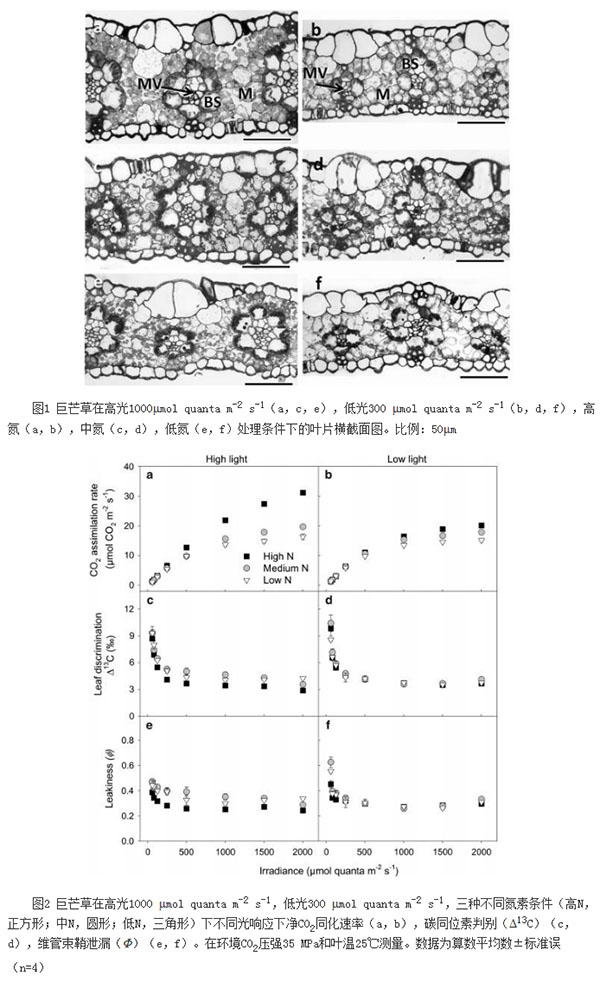Energy is the most basic driving force for world development and economic growth and an important material basis for human survival. The world today is at a critical juncture for the energy crisis. With the reduction of non-renewable resources such as coal, oil, and natural gas, the search for new types of renewable resources and energy plant basic research and planting have attracted much attention. Miscanthus × giganteus is a perennial C4 plant that is a natural grass-hybrid triad of large grasses. It can be used as a raw material for cellulose bio-energy, and has high water use efficiency and nutrient use efficiency, and it can maintain strong at low temperatures. The vitality and high biological yield. A large number of previous studies have focused on how different growth conditions (eg, light, CO2 concentration, nitrogen, salinity, drought, etc.) affect the photosynthetic efficiency of C4 plants. However, it is unclear how the biochemical properties and leaf anatomy of C4 plants drive changes in photosynthetic efficiency to adapt to the environment.
To study the characteristics of leaf anatomical structure, biochemical processes, and CO2 enrichment mechanisms of C4 energy plants under different light and nitrogen conditions, and to reveal the response of photosynthetic rate and CO2 enrichment mechanism efficiency of energy plants to low light and nutrient conditions. The mechanism has important theoretical significance for evaluating the use of C. schoolinae.
The Ma Jianying team selected by the “Thousand Talents Program†of Xinjiang Institute of Ecology and Geography, Chinese Academy of Sciences, found that the cell wall area and thickness of the vascular bundle sheath of giant scolyphous esculenta growing under high light conditions are larger than those grown under low light conditions through greenhouse cultivation and stable isotope techniques. 1) indicates that the differences in the CO2 conductance of bundle sheath cells are limited and the increased area is offset by the increased thickness. Studies have further shown that CO2 conductance of mesophyll cells under low light and nutrient limitation is the main factor limiting the activity of phosphoenolpyruvate carboxylase (PEPc), because the leakage of CO2 does not change significantly under all growing conditions ( figure 2). At the same time, the leaf carbon stable isotope composition (δ13C) is not related to the amount of CO2 leakage, indicating that the δ13C value cannot be used as an indicator of CO2 leakage. Overall, the mechanism of CO2 enrichment under low-light and nitrogen-restricted conditions is still very strong, and changes in leaf anatomy and biochemical properties help maintain the efficiency of CO2 enrichment mechanisms.

Sanitary Divert/Reversing Valves
The major purpose of Sanitary Divert/Reversing Valves is to let the medium reach the purpose of reversing or end stop, cos the good sealability and cleanability, they are extensively use to different sanitary industry areas. Kaysen Steel is the sanitary divert/reversing valves, food grade divert valves hygienic reversing valves manufacturer, exporter and supplier, material is SS304 and SS316L, size from 1"-2" Sealing material have EPDM, PTFE, NBR, etc. Standard including 3A, DIN, SMS, ISO/IDF, BS/RJT, ASME/BPE, made of three to five pipeline connector to meet the market needs, can be operaed by handle or penumatic actuator.
Sanitary Divert/Reversing Valves Specification:
Material: SS304, SS316 or SS316L
Connection Standard: 3A, DIN, SMS, ISO/IDF, BS/RJT, ASME/BPE
Port size: DN25-DN50, 1"-2"
Connection type: weld, clamp, thread
Gasket material: EPDM, PFTE, NBR
Pressure: 0.5-2bar, Vacuum:0-10bar
Temperature range: -10℃ to 120℃(EPDM)
Sanitary Reversing Valves,Sanitary Divert Valves,Food Grade Divert Valves,Hygienic Reversing Valves
Kaysen Steel Industry Co., Ltd. , https://www.chinasanitaryvalve.com